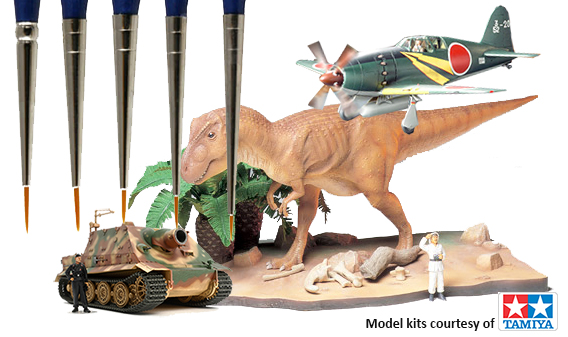What’s the trick to painting really fine freehand details like borders, lettering or the smaller components of model kits?
 Aside from a steady hand and a good eye, here are a few ideas used by professional and hobby modellers when painting detail.
Aside from a steady hand and a good eye, here are a few ideas used by professional and hobby modellers when painting detail.
First up, use really small brushes like an 18/0, with a thinner mix in your paint (acrylic thinner, not water). You have to take extremely good care of the brush tips though, so designate this brush only for features like eyes, lips, lettering and designs. Always keep your paints thin when painting details, as this provides you with more control.
Second, no matter what colour you ultimately want to achieve, start with a colour that is similar to the colour you are painting on. This gives you a way to control mistakes better and blend them back into the primary colour.
Look into using very fine tipped pens. These are great for eye pupils and painting ‘writing’. You can also drag one along grooves in models to blackline and highlight between parts and other features you want to emphasize. Toothpicks are also quite good to paint the smallest details.
Tools or jigs to hold what you are painting can be useful, although some have to be home-made for certain items. Balsa wood is great for that. When painting, resting the hand which is holding on to the jig with the part attached on a flat surface gives you better control.
Don’t try to use masking tape for two-tone paint jobs to mask two colours and expect to get a nice line. Pick up something like Tamiya or Ultraflex fine line tapes. It comes in different widths but if you use that for your fine line, then you can cover the rest with cheap masking tape to protect from over spray.
Use white primer in the air brush for all light colours and grey for darker colours. When you begin painting start with a dust coat first, at about a 90 degree angle to your masked areas.
Having lots of practice is a good idea, too, as is patience.
But before you begin, think about how the finished detail is going to be seen.
Forget the macro lens or magnifying glass – once your kit is built it’s going to be looked at from further away and rarely under optimum lighting. So maybe it’s better to get an effect, rather than an exact miniature representation of the real appearance. Think about what a painting looks like close up – it’s a swirly, globby mess of paint – but when it’s seen from the correct distance it takes form. So while you should enjoy doing fine detailed work there’s no reason to be a slave to it.
Comments are closed.